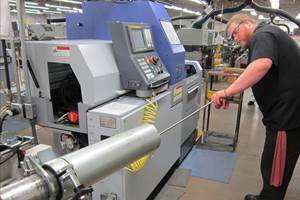Surviving A Recession
This article looks at how to keep manufacturing profits up when the economy is down.
The “R” word, “recession,” is popping up everywhere. Any time conditions are favorable for an economic downturn, it becomes as dirty a word as anything heard on “The Sopranos.” But recession does not have to be a dirty word. With the right foresight, planning and action, many manufacturing companies not only survive an economic downturn, they can benefit in the long run because of the new processes initiated such as labor optimization and inventory control created to deal with it.
Should It Stay Or Go?
The first step in preventing an economic downturn from cutting into profits is to conduct a stringent analysis and streamlining of your company’s cost structure. The administrative and operational infrastructure of all organizations tends to grow in good economic conditions, but rarely is that matched with swift reduction when business volume ebbs.
Understanding your company’s cost structure is essential for reducing or eliminating costs that don't impact sales. Both client-facing and support staff are involved in indirect expenses on a day-to-day basis. They are an excellent resource for identifying wasteful practices. An organization-wide approach to removing no longer necessary direct expenses and reducing newly unnecessary indirect expenses is the best way to ensure success.
With their input, as well as your company’s current sales projections, you can reasonably determine the available operating funds. This is very important—you need to know how much you need to cut back before beginning the process. There may be more capital to work with than originally thought.
Given the current unfavorable business environment, instead of focusing on your annual objectives, you should determine your 3-month objectives and related staff accountabilities. These decisions should be discussed with your staff members to keep everyone informed.
After determining your available working capital, formulating your business strategy is critical. Of all the initiatives currently underway, which are most likely to bring money in the door the fastest? Also, which of your initiatives would be the easiest and most cost efficient to complete? These programs should be given the highest priority. While politically easier to execute, irritants and projects with small dollar savings drain resources and attention from improvements that save big money.
Labor Optimization And Communication Is Key
Unfortunately, during an economic downturn, some hard decisions need to be made. The most obvious way to reduce costs is a reduction in staffing. A determination needs to be made between those workers that add critical value and those that don’t. One could argue that their entire staff provides critical value. In this case, which members add the least? Are there areas where responsibilities clearly overlap? In this case, one person may need to fill the shoes of two in order to weather the economic storm. Those workers that add the most critical value and are not in the firing line should be informed of this to maintain morale levels.
Employee morale is crucial to ensuring that productivity remains strong and that the corporate environment remains upbeat. It is very important that you ensure worker participation by including them in communications so they know what is going on.
This is an ideal time for additional training. Cross-training workers boosts productivity and flexibility as workers will possess the skills to “cover for” each other in the event of an illness, vacation or termination. This investment in extra training also streamlines the process flow and provides deserving workers with extra responsibilities.
Another place to start is through the examination of direct versus indirect employees. Which employees are directly involved in procurement, production, sales, promotion and supply chain? Indirect employees, usually involved in administrative and clerical roles, are often the first to go. In many cases, these employees are hourly, or non-exempt. Are there part-timers on the staff that perform unnecessary functions? A way to cut overhead without wholesale staffing reductions is through an examination of their schedules. Is there overtime that can be cut?
In order to cut labor costs, management also needs to take a long look at the contractors it currently works with. Contractors often have slower response times and are more prone to experience communication lapses. Contractors work for themselves, and often have other clients that distract their focus. Also, contractors work for a profit themselves, cutting into company profits. If there is a way to accomplish company objectives using current employees in lieu of contractors, this option should be examined.
Sales And Variable Costs In Sync
When projected sales decrease during a recessionary period, production levels need to drop proportionally. This is not the time to tie up working capital in the form of excess inventory. Management must identify costs that vary with production level and ensure that those costs are being reduced appropriately. Pay attention to the warning sign of excessive production, which is a steady inventory increase as measured by day sales in inventory.
During a downturn, management should use a multi-faceted approach to maintain or even increase company margins. One of their top priorities should be to build consistency across the organization regarding production and labor polices. If variable costs do not decrease in direct proportion to production decreases, management is failing to do their job. Essential to addressing such inconsistencies, the entire operation must be aligned toward common goals using common metrics. Performance indicators should be reviewed to ensure that they are appropriate measures of your progress to your goals.
Profit enhancing key performance indicators (KPIs) include:
- Parts produced per labor hour: This number should remain constant and within predetermined benchmarks especially when production slows down.
- Ratio of overtime hours to total labor hours: As production slows, the amount of overtime should also decrease. Preferably, production should slow at a much faster rate.
- Day’s sales in finished goods inventory: This, too, should remain constant across good times and bad.
- Day’s production in raw materials inventory: With so much focus on finished goods, tying up working capital in inventory of any form should be on your radar.
- Maintenance labor hours worked per maintenance planned hour: Planned hours require leadership approval. Are your maintenance people stretching out projects or doing unnecessary work?
- Ratio of administrative costs to total labor: If your employee count has dropped, you need to ensure that your administrative costs are downsized to match your new business structure. Do you really need the same number of customer service reps or payables clerks?
- Average span of control: Do you need as many supervisors as before if your direct labor headcount is down?
Improving Managers And Supervisors
Improving management skills among first-level supervisors or managers gives them tools to improve margins. In an economic downturn, how these front-line managers perform their jobs is crucial as they possess the ability to improve margins at the point of production. To their credit, many companies already recognize this, and are devoting greater resources to supervisor education. Unlike many types of training, the purpose of supervisor education is not just to transfer knowledge, but rather to help instill a “culture of execution,” an environment in which plans are consistently converted to action. It is the focus on results that distinguishes this education from typical “management training.” The ultimate outcome sought after is not just a trained supervisor, but rather an improved operation where the best demonstrated production is achieved consistently, and the best demonstrated performance is steadily improving.
In addition, management should seriously consider conducting an assessment of current company-wide processes and procedures. Are reporting procedures as fluent as required to support new, streamlined processes? Is company performance in line with industry benchmarks? It is essential to step out of the trenches and shift to a “fact-based view” where emotions are removed from the situation. Management should consider partnering with an operational consulting firm as such initiatives often require the perspective of an experienced and objective third party. These firms specialize in enabling the necessary program changes that adapt your company to current, as well as future business conditions.
With a little planning, cost reduction and optimization of resources, virtually any company can survive the hardship of an economic downturn. In fact, while competitors dither, lean times are periods of opportunity. All it takes is a proactive approach, proper planning, and streamlining processes. Companies that properly adapt to current conditions will see an even brighter future when the economy shifts upward.
For more information, visit Proudfoot Consulting.
Related Content
Pursuit of Parts Collector Spearheads New Enterprise
While searching for a small parts accumulator for Swiss-type lathes, this machine shop CEO not only found what he was looking for but also discovered how to become a distributor for the unique product.
Read MoreCNC Turning Tips for HRSA Materials
Rough-turning, heat-resistant superalloys can be challenging. However, new carbide insert technology provides the capability to perform high-speed, high-feed roughing in a single pass.
Read MoreUnderstanding Micro-Milling Machine Technology
Micro-milling can be a companion process to turning-based production machining. This article looks at some of the technologies that go into a micro-milling machine and why they are important to successful operation.
Read More6 Tips for Training on a Swiss-Type Lathe
There are nuances to training a person to effectively operate a Swiss-type lathe. A shop I visited a while back offers some suggestions.
Read MoreRead Next
5 Aspects of PMTS I Appreciate
The three-day edition of the 2025 Precision Machining Technology Show kicks off at the start of April. I’ll be there, and here are some reasons why.
Read MoreA Tooling Workshop Worth a Visit
Marubeni Citizen-Cincom’s tooling and accessory workshop offers a chance to learn more about ancillary devices that can boost machining efficiency and capability.
Read MoreDo You Have Single Points of Failure?
Plans need to be in place before a catastrophic event occurs.
Read More
















.jpg;maxWidth=300;quality=90)







